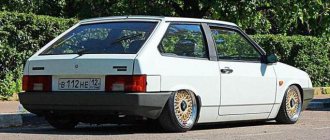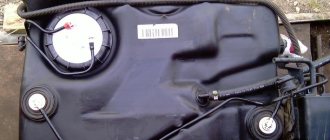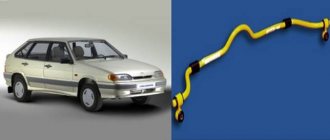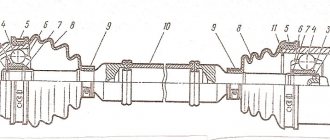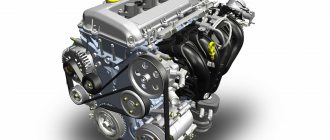A sidewalk is an element of the road that is intended only for the movement of pedestrians. According to traffic regulations, the sidewalk must be adjacent to the roadway or bicycle path and separated from them by a curb or lawn. Back in 2014, a categorical decision was made: any movement of cars, motorcycles and bicycles in the pedestrian zone is prohibited, and violation of this restriction is considered an administrative offense and is punishable by a fine.
According to the law: what is a sidewalk
The definition of a sidewalk in the traffic rules: “A sidewalk is an element of a road intended for pedestrian traffic and adjacent to the roadway or bicycle path or separated from them by a lawn.”
As happens in life: the asphalt near the house is changed and instead of a sidewalk there is a strip of gravel. Is this already a curb or still a sidewalk? According to the law, a shoulder is an element of the road adjacent directly to the roadway at the same level as it and differing in the type of surface.
What to do: traffic police officers cannot track all violations, but it is better to insure against a fine - it is better to consider such a place a sidewalk and not drive onto it. The sidewalk in the courtyard of a house is often indistinguishable from the roadway.
It is not always clear where the border between the sidewalk and the roadway is - it is better not to take risks and go around the disputed area along the road.
Places to stop
When operating a car, it is worth distinguishing between concepts such as parking and stopping. The difference between them is the time that the car can stand without moving - after 5 minutes the stop becomes a parking lot.
When a violation is detected, traffic police officers observe the driver’s behavior - if he does not remove his vehicle from a prohibited place within 5 minutes, this becomes the basis for imposing a fine. Recording of events and time usually occurs using special technical means that have been appropriately tested and can be used for such purposes.
For late payment of a fine, additional punishment is imposed (Part 1 of Article 20.25 of the Code of Administrative Offenses):
- another fine in double the amount of the unpaid amount;
- compulsory work lasting up to 50 hours;
- administrative arrest for up to 15 days.
In addition, as of July this year, a new sign 8.9.1 was introduced, which indicates parking spaces intended only for drivers with special permits. Such permission is issued by executive authorities and is valid in the territory of the region where it was received.
Who can ride on the sidewalk and when?
If the roadway is busy, the following may travel on the sidewalk:
- Fire protection
- Ambulance
- Police
- Road and utility services
- Trucks for loading/unloading
That's what the law says. In life it may be different. Here’s the situation: the driver was driving in his own lane, there was oncoming traffic across the markings, and an ambulance was flying behind. To let doctors through and possibly save someone’s life, the driver had to drive onto the sidewalk, for which he received a fine. The decision to impose a fine can be challenged - more on that below.
I missed the ambulance and received a fine. Source: pikabu
But here’s a caveat for motorcyclists: if the owner of a motor vehicle dismounts, turns off the engine and is driving his vehicle by the steering wheel, he can move along the sidewalk in this way. In this case, the owner is treated like a pedestrian.
Definition and purpose of a pedestrian path
The concept is disclosed in the Russian Federation Traffic Regulations, paragraph 1.2. This is a strip on the surface of the earth or an artificial structure that has been equipped or adapted for pedestrian movement along it. The pedestrian path is marked with sign 4.5.1 (prescriptive actions).
It looks like a circle with a blue background depicting a white human silhouette in motion.
The meaning of the sign is simple: it defines a separate area in the area where only those who, according to the rules, are considered pedestrians, are allowed to move.
We are talking not only about walking people, but also about disabled people moving with the help of a special stroller, cyclists, roller skaters, moving with the help of scooters, hoverboards, etc. A certain width is also provided for the pedestrian crossing.
Pedestrians must follow the rules: move in the designated area, sidewalk or bike path. If they are not there, you need to move along the side of the road (clause 4.1 of the Rules).
What is the fine for driving on the sidewalk?
If the driver simply drove around the traffic jam and returned to his lane, he will simply receive a fine for driving on the sidewalk in a car. If you hit or hit a pedestrian, the responsibility is much higher. Here is a list of violations and responsibility for them.
| Violation | Fine for driving on the sidewalk |
| Driving on the sidewalk, fine 2021 | 2000 rubles |
| Pedestrian hit (minor injury) | From 2,500 to 5,000 rubles. Or deprivation of rights for up to 1.5 years. |
| Knocked down pedestrian (moderate injury) | From 10,000 to 20,000 rubles. Or deprivation of rights for up to 2 years. |
| Pedestrian hit on sidewalk (death or serious injury) | Up to 4 years in prison |
Article 12.15.2 of the Code of Administrative Offenses of the Russian Federation
Driving on bicycle or pedestrian paths or sidewalks in violation of the Traffic Rules - entails the imposition of an administrative fine in the amount of two thousand rubles.
Here's how the law defines severity:
| Minor harm | Medium severity | Serious harm |
| short-term health disorder | long-term health disorder | harm dangerous to human life |
| minor permanent loss of general ability to work | significant permanent loss of total working capacity of less than one third | loss of vision, speech, hearing or any organ or loss of organ function |
| abortion | ||
| permanent facial disfigurement | ||
| significant permanent loss of general ability to work by at least one third | ||
| complete loss of professional ability to work |
It happens that the camera or the traffic police officer make a mistake, and the fine comes to the wrong car. It's better to be safe and check.
For cyclists, sidewalks and roads! SDA-2019
Photo: ESP Cyclists are a nuisance to both motorists and pedestrians. How to deal with them?
A cyclist is an elusive offender, frightening pedestrians with children, dogs, strollers walking calmly on the sidewalk, scurrying between cars and annoying motorists. How to put it in place? We open traffic rules together with Olga Kholopova.
At the very beginning of the traffic rules, motorists will be disappointed. It turns out that a bicycle is a vehicle (vehicle), and a cyclist is called a big word - a driver! It follows from this that he is guided by almost all traffic rules. There’s even a whole section dedicated to him personally—Section 24 of the Traffic Rules! In addition, it can have an electric motor with a power not exceeding 0.25 kW. So can this impudent person disturb joyfully strolling dogs along the sidewalks and comfort-loving motorists?
In general, the home environment of a cyclist over 14 years of age is a bicycle and bicycle pedestrian path, as well as a lane for cyclists (24.1 traffic rules). Alas, there are practically no such things in our city and, in the absence of the above, traffic regulations send the disturbing cyclist to the right edge of the roadway (FR)! At the same time, the overall width of the bicycle, its trailer, or the cargo being transported should not exceed 1 m. Cyclists are also required to move there in columns. And only if it is not possible to drive along the right edge of the inverter, they are allowed to drive along the side of the road without interfering with pedestrians! Did pedestrians feel like they were on a horse? Not so! If there is no shoulder, then the cyclist goes straight to the sidewalk and pedestrian paths. And if he accompanies a cyclist under the age of 14, or transports a child in an additional seat, bicycle stroller or trailer, then he is generally a full user of the sidewalk. In any case, the cyclist must not interfere with pedestrians, otherwise he will have to dismount (24.2, 24.6). By the way, a cyclist carrying a child can move in any of the above zones, including the IF. So, for cyclists over 14 years old there are as many as 6 zones for movement. But there is also a seventh zone in which they cannot move - this is the pedestrian zone. Cyclists aged 7 to 14 years old can travel in pedestrian zones, as well as on sidewalks, pedestrian, bicycle and pedestrian paths (24.3). The youngest cyclists (under 7 years old) are most restricted. Their lot is sidewalks, pedestrian and bicycle paths (on the side for pedestrian traffic, since their speed is too low), as well as pedestrian zones (24.4). It is worth noting that moving along them is not as easy and safe as it seems. Pedestrians can stop suddenly, turn around and walk diagonally. Lack of experience riding a bicycle can lead to a collision.
All this has probably already frayed the nerves of unfortunate pedestrians and motorists, but how will the latter react to a column of cyclists?! But they are allowed to ride in a group of 10 people in one row or even 10 pairs in two rows, if the overall width of their bicycles does not exceed 0.75 m (cargo, trailer) and to the delight of motorists, legislators took care of making it easier to overtake such a convoy and set the distance between groups to 80 - 100 m (24.7).
“Cyclists are prohibited from riding on sidewalks! Your place is one meter on the right on the road!” These norms disappeared from traffic rules about 25 years ago!
Lanes for route vehicles
A huge gift for cyclists was the update of clause 18.1 of the traffic rules! Now they are allowed to drive in the lanes for fixed-route vehicles, if such a lane is located on the right! Such lanes are indicated by the following signs: 5.11.1, 5.13.1, 5.13.2, 5.14. But, no matter how good the gift, the work of the traffic police leaves much to be desired. Often there is a brick hanging on the lanes for route vehicles, under which a cyclist is not allowed to drive. The way out of this situation is simple: accompany the brick with a sign 8.4.13 or even leave only the sign 5.14.1.
Basic provisions for admitting a vehicle to operation, lighting devices and sound signal
The basic provisions for admitting a vehicle to operation oblige the cyclist to have a working brake, steering wheel and sound signal. But you shouldn’t honk your horn in pedestrian areas, because the cyclist is a guest there. It is worth noting that fixed weights are prohibited for driving around the city and on roads outside of it, since they do not have brakes, but if desired, they can be equipped with a front hand brake. Also useful for cyclists will be paragraphs 2.3 and 2.3.1, which tell about the general responsibilities of drivers in general. In turn, one of the most important rules is the presence of lighting equipment when driving in conditions of poor visibility (fog, rain, snowfall, twilight), as well as in tunnels. The bicycle must be equipped at the front with a reflector and a white light or headlight, at the rear with a red reflector or light, and on each side with an orange or red reflector.
In the event of an accident outside populated areas in the dark or in conditions of limited visibility (visibility limited by the terrain, geometric parameters of the road, vegetation), while standing on the roadside or on the side of the road, you must wear a jacket, vest or cape vest with stripes of reflective material (2.3.4 .). Advice: without the above things, a cyclist just needs to get off the road and the side of the road.
In the latest amendments to the traffic rules, an ambiguous clause for cyclists has appeared: 19.5. “During daylight hours, all moving vehicles must have low-beam headlights or daytime running lights turned on for the purpose of identifying them.” It caused a lot of discussions and controversy on the Internet. However, the basic provisions for permitting a vehicle to operate do not oblige the cyclist to equip the bicycle with headlights and daytime running lights. Therefore, clause 19.5 does not apply to bicycles. Also, in paragraph 24 there is no prohibition on operating a bicycle without these lighting devices.
“Unlike a car, a bicycle is not a high-risk vehicle because it is under the complete control of a person”
Helmet
According to traffic regulations, a helmet is not a necessary attribute for a cyclist. Whether to use it or not is everyone’s own choice. Some believe that wearing a helmet may only increase your risk of traumatic brain injury (TBI). Studies have been conducted in Europe and the United States that claim that the likelihood of getting a TBI while walking down the street is higher than while riding a bicycle. But for a more accurate result, it was worth considering a specific age group of people. What is the probability of death in the event of a TBI on the sidewalk and while driving at speed at IF? There is also an article that states that drivers passing cyclists wearing a helmet drove an average of 8.5 cm closer than when passing cyclists with their heads unprotected. Thus, the article concludes that a cyclist wearing a helmet will be more protected, but his chance of getting into an accident increases. This article is very controversial because in addition to displacement from the IF, there are other types of collisions in which a helmet can save a life. Draw your own conclusions.
“Is it possible to cross a controlled crossing at a zebra crossing?” This was discussed in the media, but did not come into force
Gestures
Wherever a cyclist goes, he must be predictable and give advance warning of his intentions. In particular, when turning and stopping, traffic rules require the use of gestures. When turning to the right, you need to extend your right arm to the side or extend your left arm to the side and bend your elbow at a right angle upward. When turning left, extend your left arm or bend your right arm at a right angle upward. When stopping, raise either hand up (8.1). It is important to take into account the speed of vehicles behind and signal in advance (8.2). In addition, turning and stopping while holding the steering wheel with one hand is unsafe! Experienced cyclists also advise warning the following cyclist about the presence of potholes and other dangers along the way by extending your arm down to the side, depending on which side the danger is from. Newbies, out of habit, are embarrassed to give signals with gestures. By the way, at first they do not feel at all like full participants in the road traffic. But everything comes with experience.
Driving through intersections
To begin with, you should pay attention to clause 13.1 and do not forget that when turning right or left, the driver is obliged to give way to cyclists crossing the roadway onto which he is turning. Unlike motorists, a cyclist has more limited freedom of action during such maneuvers. Turning right is no problem, but turning left is a problem. It is allowed only in a few cases:
- in the case of single-lane traffic in the absence of tram tracks;
- provided with a bicycle path;
- allowed from the far right lane at a T-junction in multi-lane traffic (photo). Until this year, the last maneuver was subject to a direct ban, which was spelled out in paragraph 24.8. If there is no opportunity to turn left, then some use the “Copenhagen turn”. This is a left turn in two stages, when the cyclist first crosses the inverter directly (which he wants to turn into), stops on it in front of the cars, then turns left and waits for the green light to turn on in that direction (photo). However, such a maneuver is not provided for in traffic rules. And it can be dangerous if a turn from the far right lane to the right following the arrow is allowed on the crossing. The moment you decide to drive there and stop for a turn, there may be a car turning right without even slowing down. In all other cases, the cyclist must dismount and use the pedestrian crossing.
“Traffic regulations do not regulate the distance when ahead of a cyclist. Recently there was an attempt to introduce a lateral spacing of 1 m, but it was not accepted. Therefore, today, the distance is considered safe until an accident occurs.”
Prohibitions
Traffic regulations prohibit cyclists (24.8):
- ride without hands;
- transport cargo that interferes with control and protruding cargo by more than 0.5 m in length or width beyond the dimensions;
- transport passengers if this is not provided for by the design of the vehicle or there are no equipped seats;
- turn left on roads with tram traffic and on roads with more than one lane (except when turning left from the right lane is permitted);
- cross the road on a bicycle at pedestrian crossings!
- towing bicycles with bicycles (24.9). You can also supplement them with other prohibitions emanating from traffic rules:
- drive the bike against the direction of travel;
- drive on the motorway at speeds less than 40 km/h (16.1);
- It is also worth paying attention to the signs: 3.1, 3.2, 3.9, 4.5.1, 5.1, 5.3, 5.33 and paragraph 11.6 of the traffic rules: if it is difficult for a cyclist to get ahead of a cyclist outside populated areas, he must go as far to the right as possible, and, if necessary, stop to let the next one pass TS behind him.
Fines
To our deep surprise, the Code of Administrative Offenses does not consider a bicycle to be a vehicle. According to the definition of the Code of Administrative Offenses, a vehicle is a motor vehicle with an engine of much greater power than 0.25 kW. Despite this, there is a special article dedicated to cyclists, which stipulates a fine of 800 rubles for any traffic violation by a cyclist. and 1000-1500 rub. for any violation while intoxicated (part 2, page 12.29). However, the cyclist is subject to another article of the Code of Administrative Offenses regarding violation of traffic rules, resulting in interference with the movement of a vehicle or causing slight or moderate harm to the health of the victim” (Part 2, p. 12.30).
Reader Questions
Can a cyclist's driver's license be revoked? (Alexander, Saransk)
No, unless we are talking about an electric bike with a power of more than 0.25 kW. (clause 2.1.1).
Am I required to show my passport to the traffic police officer? (Maria, Saransk)
Yes, in case of violation of traffic rules or to attract as a witness or witness (clause 107 of the administrative regulations of the Ministry of Internal Affairs).
Does the traffic police officer have the right to check the frame number of my bicycle? (Alexey, Saransk)
Yes, these are his direct responsibilities according to clause 107 of the administrative regulations of the Ministry of Internal Affairs. A traffic police officer can check the frame as part of certain orientations and special events. Despite this, he is not required to present documents for inspection, but they may be located at the traffic police post, or even instructions about special measures may be given to the employee orally.
Why don't cyclists pay road tax? (Vladimir, Saransk)
The influence of the bicycle on the road surface is minimal, it is lightweight.
conclusions
A cyclist is the same full participant in the traffic as a motorist and a pedestrian. This is an environmentally friendly form of transport. With the help of a bicycle, a person improves his health and solves leisure problems. The more city residents switch to bicycles, the more congested the roads will be. Public transport will not be stuck in traffic jams, the number of accidents will be reduced. Since the beginning of this year, 30 people have already died in car accidents in Mordovia! But our region and the country as a whole seem to be indifferent to such statistics. The cycling infrastructure is practically not developing and therefore the prospect of abandoning the car in favor of a bicycle seems extremely doubtful. The more cyclists on the roads, the more accustomed drivers become to sharing the roadway with them.
So remember everything written above and go ahead - ride! Remember that knowledge of traffic rules does not replace your attentiveness!
If you have questions about the cycling topic, call: 8-917-697-83-18. We will definitely answer them in the next issues of Velostolitsa. In the meantime, read how the opening of the cycling season went in Saransk and Ruzaevka.
What to do if you are stopped
Even if you violated it in front of an inspector, you have these rights.
- Explain your actions or refuse to testify.
- Ask about the reason for the stop.
- Don't get out of the car.
- Film everything that happens, including the inspector, on camera.
- Read the protocol and get a copy.
- Do not sign the protocol.
- Specify the telephone number of the duty station where the inspector serves, his rank, first and last name.
- Do not give away rights without a court order.
- Refuse to search without witnesses and video recording.
- And the main thing is not to pay a fine for driving on the sidewalk on the spot
Who is allowed to use the pedestrian path?
Access to the pedestrian path is possible in the following cases:
- If the transport belongs to municipal and road maintenance organizations that need to perform their direct work responsibilities on site.
- When it is necessary to bring cargo to commercial and other buildings, provided that there are no other options for access to them. The shortest path should always be chosen.
When crossing the zone, the driver of the vehicle is obliged to maintain safety, since in the territory priority in movement is given to citizens on foot.
Pedestrians must also be vigilant and avoid dangerous situations.
Certain categories of citizens who do not travel on foot are allowed to use the pedestrian path. We are talking about cyclists:
- who are under 14 years old;
- adults moving in the area where the sign is valid, together with cyclists under 14 years of age;
- carrying with them a child (children) under 7 years of age;
- If a cyclist is over 14 years old, he has the right to enter the path only if there is no special zone for cyclists nearby and movement on the side of the road or the right side of the road is prohibited.
If this creates obstacles to the movement of pedestrians in the zone, you will have to get off the bicycle and drive it nearby.
Who should you expect a fine from and what will happen if you don’t pay?
Driving on the sidewalk still needs to be proven. The basis for a fine may be:
- testimony of witnesses to the violation
- video recording
- the violator was noticed by a traffic police officer
After the camera has taken and sent the photo, the information is checked by a traffic police officer - he looks at the legibility of the license plate and markings. Then the inspector makes a decision and sends it in printed form to the Russian Post terminal. The information is stored on the traffic police server - you can check it at any time. How much is the fine for driving on the sidewalk? It happens that an inspector sees a violation, but has nothing to prove. That's why.
If the markings are not visible due to precipitation, the officer will not be able to issue a fine. This is one of the reasons why road services try to quickly remove fallen snow.
If the markings were not visible, you can challenge the fine
If the fine could not be contested and it was not paid within twenty days, the driver is obliged to pay double the tariff. If after ninety days the fine is still not paid, the inspector takes the matter to court. Further, the court will collect money, and if this is impossible, then the violator will receive arrest for up to fifteen days or forced labor for up to fifty hours.
What does the driver face for violating it?
Chapter 12 of the Code of Administrative Offenses of the Russian Federation regulates liability for traffic offenses.
Driving into a pedestrian zone and parking in the wrong place is punishable as follows:
- The fine for driving on the sidewalk is 2,000 rubles (Part 2 of Article 12.15 of the Administrative Code).
- For stopping or parking, the driver will pay 500 rubles (Part 1 of Article 12.19 of the Administrative Code).
If the vehicle is parked with one wheel on the curb, the traffic police officer also has the right to fine the car owner for parking on the sidewalk.
The sanction for violating the rules for the movement of cars in pedestrian areas is the same for all regions of Russia. From 2021, there is a discount on payment of 50% of the fine within 20 days after receiving the decision with the details.
How to appeal a fine
Within ten days you have the right to challenge the decision of the traffic police officer. If the fine is issued by an inspector, the period begins to expire from the next day. And if there was photographic recording - from the next day after you received a copy of the decision by mail. There is no state duty to appeal; you just need to fill out the complaint correctly.
If you were late for the wedding, write so. The court will take it into account.
You can also ask for a reduction in the fine:
How does this work in real life?
Rules are made to be followed. However, the realities of life differ from the prescriptions established on paper. There are exceptions to any rule.
Situations where driving or parking on sidewalks may be permitted:
- access to shopping areas located in pedestrian areas;
- access to parking lots located inside the residential complex.
The actions of traffic police officers may be different in cases that seem the same at first glance.
Travel to your place of residence
There is an official parking lot for residents inside the block of apartment buildings. Access to the parking lot is only possible along the sidewalk. The traffic police stopped the driver in the middle of the pedestrian zone. The motorist presented a document confirming his place of residence, which justified the traffic violation. Now similar situations are widespread throughout the country.
Entrance to the store
The retail outlet, located in a pedestrian area, has a special passage for unloading goods. The driver drove onto the sidewalk because the driveway was occupied by another vehicle. The traffic police inspector drew up a report and fined the driver 2,000 rubles. The driver's excuse that he needed to unload the goods was not accepted by the court on appeal. In this situation, the new car had to wait until the passage was free.
What about parking on the sidewalk?
The traffic police fine for parking on the sidewalk in 2021 is 1,000 rubles, and in Moscow and St. Petersburg it is 3,000 rubles. Even if it was just a collision on the sidewalk, the inspector will still issue a fine. In addition, the car can be towed - you will have to pay for a tow truck and impound lot. In the capitals it is about 2500 rubles per day. The discount works the same way: within twenty days from the date of the decision. Read more about this in the article about fines for parking on the sidewalk.
All articles by the author: Evgeniy Lesnov
Understanding the concepts
To understand what a sidewalk is, just look at the traffic rules. The text regarding sidewalks was not changed in 2015 and 2021, and was also left unchanged in 2021 and 2021. Therefore, as before, a sidewalk is considered an element of the road that is specifically designed for the movement of pedestrians.
In this case, sidewalks adjoin the roadway or special paths intended for cycling.
What it looks like in reality
We are already accustomed to the fact that the reality of life differs significantly from the prescriptions and established rules. And in most cases, both potential violators themselves and law enforcement officers who are called upon to ensure compliance with the law understand this. For example, in large cities, a huge number of retail outlets are adjacent to the sidewalks, which automatically creates a large field of activity for those who like to travel on the sidewalk and those who are called upon to prevent this. Here are a few examples of how the rule prohibiting driving on the sidewalk works or does not work in practice.
Example one
The driver drove a truck to the store, located near the sidewalk, to unload goods. At the same time, he had to drive several tens of meters along the sidewalk. This was noticed by a traffic police patrol located in the immediate vicinity. In addition, the video recording of the police car recorded the maneuver performed by the truck. The traffic police inspector filed a complaint against the truck driver for violating the relevant traffic rule. The driver expressed his disagreement in the protocol, since driving on the sidewalk is permitted when loading or unloading goods. But the most important thing in this case is that the store had another entrance for loading and unloading, which excluded a prohibited maneuver. It was only necessary to drive another two hundred meters. Whether the driver knew about it or not, this nuance will lighten his wallet by 2,000 rubles. The driver is wrong, since driving on the sidewalk could have been avoided.
Example two
The car drove onto the sidewalk, moving towards a permitted parking spot near a residential building. There was no other entrance to the house. The traffic police patrol approached the potential violator and inquired about the reason for his prohibited maneuver. The driver said that he lives in this house and was able to confirm this with the appropriate document. The police looked at the documents and wished the driver a happy day, since he did not violate the Traffic Rules due to the fact that he drove into a parking lot near his place of residence. And for some reason another visit to the house was not provided. A similar situation often happens in provincial cities and at the entrance to houses in which there are few apartments and there are no legally established entrances for transport.
Example three
The minivan drove up to a cigarette kiosk adjacent to the sidewalk and located not far from the highway. To do this, he had to drive about 300 meters along the sidewalk. The traffic police inspector filed a complaint against the driver of the minivan, since the distance from the cigarette kiosk to the highway is only about ten meters. Stopping and parking at this point on the road is permitted. The volume of product unloaded into a cigarette stall could be carried in one's hands while parking a car on the side of the road. The delivery driver expressed his disagreement in the protocol drawn up. When the case was considered in court, it was decided that the driver was innocent. Although in fact this situation is ambiguous, and the court could well have made the opposite decision. The driver’s main argument in his own defense was that he could not carry all the ordered products in his hands to the retail outlet, and in the car there were a lot of expensive goods that could not be left unattended for a long time.
Example four
The car was moving quite quickly along the sidewalk, periodically signaling to people passing by, demanding that they give way. One of the outraged pedestrians filmed this maneuver on a smartphone. In the evening, he posted a copy of the video file on a special traffic police portal. In the notes, he described in detail the time when the offense occurred, the place where it happened, the number and make of the car driving in an unidentified location. In addition to everything, he left his personal and contact information. The next day, a letter was sent to his email notifying him that the complaint about the offense had been accepted for consideration. The driver was brought to administrative responsibility. He tried to challenge his innocence in court, but he failed, since the entire offense was recorded on video by a conscious pedestrian. The latter had to testify in court; he also invited his fellow traveler as a witness, with whom they were walking home from work on the day when the video about the violation of traffic rules was filmed. As a result, the impudent man was punished according to the law.
If in this situation pedestrians decided to take on the role of justice and tried to restore justice using not entirely legal methods, then they would end up in the dock together with the offending driver, since they committed hooligan acts.

